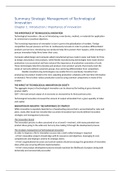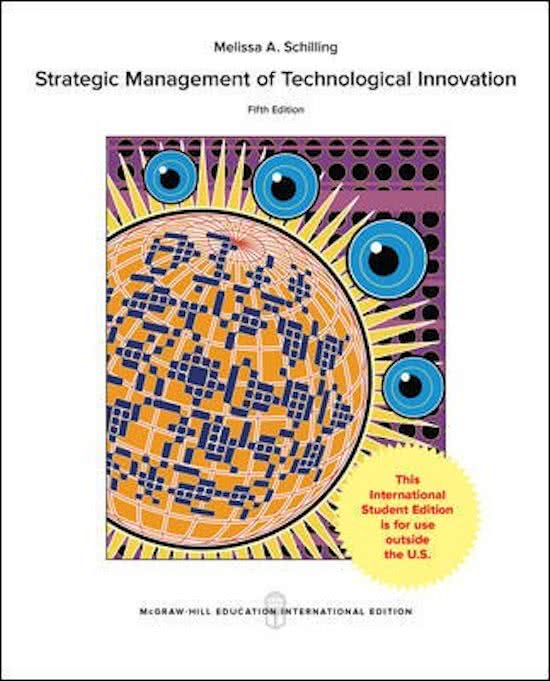Summary Strategic Management of Technological
Innovation
Chapter 1: Introduction / Importance of innovation
THE IMPORTANCE OF TECHNOLOGICAL INNOVATION
Technological innovation = the act of introducing a new device, method, or materials for application
to commercial or practical objectives.
The increasing importance of innovation is due in part to the globalization of markets. Foreign
competition has put pressure on firms to continuously innovate in order to produce differentiated
products and services. Introducing new products helps firms protect their margins, while investing in
process innovation helps firms lower their costs.
Computer-aided design and computer-aided manufacturing have made it easier and faster for firms
to design and produce new products, while flexible manufacturing technologies have made shorter
production runs economical and have reduced the importance of production economies of scale.
These technologies help firms develop and produce more product variants that closely meet the
needs of narrowly defined customers groups, thus achieving differentiation from competitors.
Flexible manufacturing technologies now enable firms to seamlessly transition from
producing one product model to the next, adjusting production schedules with real-time information
on demand. Firms further reduce production costs by using common components in many of the
models.
THE IMPACT OF TECHNOLOGICAL INNOVATION ON SOCIETY
The aggregate impact of technological innovation can be observed by looking at gross domestic
product (GDP).
GDP = the total annual output of an economy as measured by its final purchase price.
Technological innovation increased the amount of output achievable from a given quantity of labor
and capital.
INNOVATION BY INDUSTRY: THE IMPORTANCE OF STRATEGY
While innovation is popularly depicted as a freewheeling process that is unconstrained by rules and
plans, study after study has revealed that successful innovation have clearly defined innovation
strategies and management processes.
The innovation funnel
The innovation process is often conceived of as a funnel (= trechter), with many potential new
product ideas going in the wide end, but very few making it through the development process.
The strategic management of technological innovation
In order to improve a firm’s innovation success rate a well-crafted strategy is required:
- A firm’s innovation projects should align with its resources and objectives, leveraging its core
competencies and helping it achieve its strategic intent.
- A firm’s organizational structure and control systems should encourage the generation of innovative
ideas while also ensuring efficient implementation.
- A firm’s new product development process should maximize the likelihood of projects being both
technically and commercially successful.
,To achieve these things, a firm needs:
- An in-depth understanding of the dynamics of innovation.
- A well-crafted innovation strategy.
- A well-designed processes for implementing innovation strategy.
,Chapter 2: Sources of innovation
OVERVIEW
Innovation = the practical implementation of an idea into a new device or process.
Innovation can arise from many different sources:
- Individuals
- Universities
- Government funded research
- Private nonprofits
- Firms
CREATIVITY
Innovations begins with the generation of new ideas.
Individual creativity
An individual’s creative ability is a function of his or her intellectual abilities, knowledge, style of
thinking, personality, motivation and environment. The most important intellectual abilities for
creative thinking include the ability to look at problems in unconventional ways, the ability to analyze
which ideas worth pursuing and which are not, and the ability to articulate those ideas to others and
convince others that the ideas are worthwhile.
If an individual has too little knowledge of a field, he or she is unlikely to understand it well enough to
contribute meaningfully to it. On the other hand, if an individual knows a field too well, that person
can become trapped in the existing logic and paradigms, preventing him or her from coming up with
solutions that require an alternative perspective.
Organizational creativity
The creativity of the organization is a function of creativity of the individuals within the organization
and a variety of social processes and contextual factors that shape the way those individuals interact
and behave. The organization’s structure, routines, and incentives could thwart individual creativity or
amplify it.
Idea collection systems (such as suggestion boxes) are relatively easy and inexpensive to implement,
but are only a first step in unleashing employee creativity. Today, some companies go further with
creativity training programs. Such programs encourage managers to develop verbal and nonverbal
cues that signal employees that their thinking and autonomy are respected. These cues shape the
culture of the firm and are often more effective than monetary rewards.
TRANSLATING CREATIVITY INTO INNOVATION
Innovation requires combining a creative idea with resources and expertise that make it possible to
embody the creative idea in a useful form.
The inventor
The most successful inventors possess the following traits:
1. They have mastered the basic tools and operations of the field in which they invent, but they have
not specialized solely in that field; instead they have pursued two or three fields simultaneously,
permitting them to bring different perspectives to each.
2. They are curious and more interested in problems than solutions.
3. They question the assumptions made in previous work in the field.
, 4. They often have the sense that all knowledge is unified. They seek global solutions rather than local
solutions, and are generalists by nature.
Innovation by users
While manufacturers typically create new product innovations in order to profit from the sale of the
innovation to customers, user innovators often have no initial intention to profit from the sale of their
innovation – they create the innovation for their own use. Users may alter the features of existing
products, approach existing manufacturers with product design suggestions, or develop new products
themselves.
User innovations can also blossom into new industries.
Research and development by firms
Basic research = effort directed at increasing understanding of a topic or field without a specific
immediate commercial application in mind.
Applied research = directed at increasing understanding of a topic to meet a specific need. In industry,
this research typically has specific commercial objectives.
Development = activities that apply knowledge to produce useful devices, materials, or processes.
Firms consider their in-house R&D to be their most important source of innovation. Also, a firm’s R&D
intensity has a strong positive correlation with its sales growth rate, sales from new products, and
profitability.
1950s and 1960s: science-push approach to R&D.
mid-1960s: demand-pull model of R&D.
Firms that are successful innovation utilize multiple sources of information and ideas, including:
- In-house research and development, including basic research.
- Linkages to customers or other potentials users of innovations.
- Linkages to an external network of firms that may include competitors, complementors, and
suppliers.
- Linkages to other external sources of scientific and technical information, such as universities and
government laboratories.
Firms linkages with customers, suppliers, competitors, and complementors
Firms often form alliances with customers, suppliers, complementors, and even competitors to jointly
work on an innovation project or to exchange information and other resources in pursuit of
innovation.
Collaborators can pool resources such as knowledge and capital, and they can share the risk of a new
product development project.
Doing in-house R&D helps to build the firm’s absorptive capacity, enabling it to better assimilate and
utilize information obtained externally.
Universities and government-funded research
Another important source of innovation comes from public research institutions such as universities,
government laboratories, and incubators.
To increase the degree to which university research leads to commercial innovation, many
universities have established technology transfer offices. This are offices designed to facilitate the
transfer of technology developed in a research environment to an environment where it can be
commercially applied.






